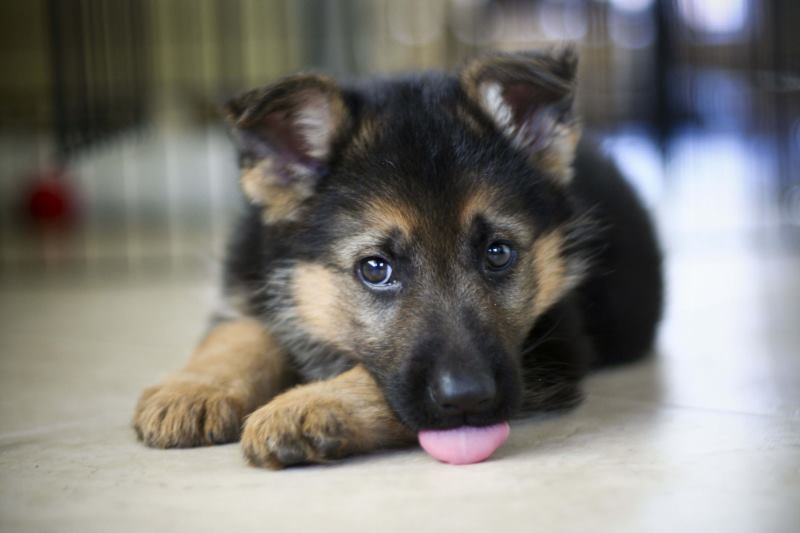What if you notice that the puppy has diarrhea with blood? How to identify the causes of the disease and provide timely assistance? Let’s understand the symptom of what disease can become bloody diarrhea.
Contents
Diarrhea with blood is a symptom
Diarrhea and indigestion are just symptoms. Dilution of stool and as a consequence of diarrhea, this is the reaction of mucous membranes and a natural defense mechanism.
Ordinary diarrhea is not “scare” even an inexperienced dog owner, but when a puppy begins diarrhea with blood, everyone can panic. What can cause the presence of blood in the stool? In fact, there are a lot of options.
The most “safe” option is the destruction of several blood vessels. This happens as a result of a sharp drop in blood pressure, stress, excessive excitation or fatigue. Blood vessels burst, a small amount of blood goes into the intestine and leaves the body in a natural way. This “bleeding” quickly stops without intervention, as in this process platelets participate, with the help of which blood is clotted. 10-12 hours after the destruction of the vessels, the mucous membrane is completely restored.
Ingestion of foreign objects is a very common problem faced by the owners of small puppies. Curiosity of the child can bring to the trouble … literally words.
If the foreign object is ingested, there are two possible outcomes:
- If the object is smooth and small, it will pass through the digestive system and will leave the body naturally by the next defecation.
- The situation is much more complicated if the foreign object has sharp angles and can injure the mucous membranes. What can be attributed to dangerous foreign objects? For example, small details from the child’s designer, toothpicks and matches, pieces of twigs and chips, needles, nails, clerical buttons, paper clips, fragments of foil and so on.
Important! Particular danger is a film that does not cause diarrhea with blood, but can lead to blockage of the intestine and the death of the puppy in a matter of hours.
So, if a dog swallowed a foreign object with sharp fragments, the mucous membranes of the stomach and intestines are likely to be damaged. If the size of the object is small, despite all the damage, it will come out naturally, but the bleeding will begin before that.
The most dangerous thing from the whole “list” is a needle. The stomach, intestines and even the esophagus contract during work. The needle can pierce the organ wall and move into the body cavity in an absolutely unpredictable direction. In veterinary practice, recorded cases of curing a needle from the lungs and the heart after swallowing.
Diarrhea with blood as a symptom of poisoning
Despite studies that showed that most of the population of our planet loves dogs, there are people who do not like or even try to harm them. The so-called doghanters, who consider their “mission” to clear the territory of homeless animals, deliberately throw bait in the streets with rat poison or isoniazid.
The action of the poison extends to all animals, regardless of whether they are domesticated, whether they received vaccinations, how well they fed. If the puppy during a walk will pick up such a treat, dangerous symptoms will develop very quickly. The first signs of poisoning are standard: nausea, vomiting, weakness.
When poisoning with poison and tubazid, the clinical picture is very rapidly developing. In both cases, the dog has convulsions and seizures. During a seizure, the dog can not be controlled, it does not hear anything and does not see anything. After a seizure, the dog begins vomiting and involuntary emptying of the intestine. In fecal masses there is an abundant amount of scarlet blood, indicating that the mucous membranes of the digestive system are rapidly destroyed.
When poisoning with rat poison, the dog develops dehydration very quickly, it literally dries up before the eyes. In this case, the animal has increased thirst, but the more the dog drinks, the worse it becomes. At a critical time, the dog begins bleeding from the anus. If the body lacks strength, it provokes vomiting, while in the vomit masses there is a red foam and a copious amount of non-coagulated blood.
Remember, if the dog started diarrhea with blood right after the walk, you should drop everything and deliver the pet to the veterinarian.
When poisoning with rat poison or tubazid, time goes by the clock, and in the case of a puppy, for a minute. The only chance of saving an animal is the timely introduction of an antidote.
Be careful! In addition to poison, bait can be stuffed with needles, screws, nails or clerical buttons.
Even if in the veterinary clinic (by a lucky coincidence) an antidote will be found from the type of poison you need, the pet will not get out of the other world without a course of detoxification. Most likely, if the dog can be saved, rehabilitation will take from several days to several weeks. At the same time, the primary task will be to eliminate dehydration, restore the liver and kidneys.
The owner needs to understand that poisoning of this kind can not pass without a trace. In order not to struggle with the consequences and chronic pathologies, it is necessary to walk the dog in a muzzle, even if it does not have the habit of picking food from the ground.
Diarrhea with blood, as a symptom of infection with the virus
Diarrhea with blood in a puppy can be called a starting line for the treatment of enteritis. Parvovirus enteritis is a virus that a puppy can “pick up” on a walk, sniffing grass or drinking water from a puddle, losing with a stick (which was lying on the ground).
Important! A frightening number of animals is infected with enteritis after a preventive visit to the veterinary clinic.
From enteritis there are vaccinations, but they do not guarantee that the dog will not get sick. In recent years, statistics are frightening, since a very large percentage of vaccinated dogs suffer from enteritis in acute form. Logically, if you vaccinated a dog, and she was in contact with a virus carrier, she will get sick, but will bear the disease easier.
Veterinarians pay attention to the fact that over the past 5 years the pattern of enteritis has significantly worsened. Despite the preventive vaccination, puppies are very difficult to tolerate viral enteritis and often die from it.
Inexperienced owners believe that enteritis is something that develops in the intestines and stomach. In fact, this ailment is viral, it multiplies and develops in the blood. The first symptoms: a slight increase in temperature, lethargy, apathy and refusal to eat, are usually released from attention … and the problem is not the owner’s inattention, but the speed of the disease.
The incubation period after infection with enteritis can last from 3 to 5 days. On the day when the virus will make itself felt events will develop very quickly. After a brief apathy, which lasts 4-5 hours, you will find that the puppy is completely exhausted, lies on his side, can not eat and drink. Even if the puppy gets up, his gait is uncertain. After 1-1.5 hours, acute diarrhea and vomiting develop.
The first few defecations “expel” the remaining stool from the body, they can be liquefied or watery. The first symptom of the final diagnosis of “enteritis” is a change in the color of the feces to green. In addition, with enteritis, feces have a specific smell of rot. This smell can not be confused or missed.
Green diarrhea can last from several hours to several days, after which, in the feces of the dog appears blood. How it will look difficult to predict. Sometimes slime with blood clots comes out of the dog’s intestine. It happens that blood flows from the anus. If the dog received nutrition in the feces there are crimson clots with mucus, it is nothing but fragments of the mucous membrane.
Enteritis is a very dangerous disease with a high mortality rate. Do not be afraid of the explanation below, but more clearly the process of the disease can not be described. So, when a dog is sick with enteritis, it goes through several stages. Refusing food is a natural defense mechanism, diarrhea is a natural cleaning mechanism. It is important that the dog was on a starvation diet, otherwise her condition will deteriorate sharply.
Note! When the dog is ill with enteritis, the bacteria in the intestine are constantly multiplying, which “start” the process of putrefaction and fermentation. In parallel with this process, the mucous membrane of the intestine literally sprawls and comes out with calves.
The mucous membrane stops within 10-12 hours precisely this period will become critical. Since the organism of the puppy will be deprived of food, and possibly of water, it must be maintained. Usually, puppies are given abundant droppers with buffer solutions, glucose, vitamins and microelements. A hungry diet with enteritis can last from 3 to 10 days.
Treatment of enteritis is very troublesome and time-consuming. In a critical period, which can last up to 10 days, the puppy needs to put drippers. The average periodicity of intravenous infusions varies from 2 to 4 hours during the day and at night.
In addition to intravenous injections, puppies are given immunoglobulin serums and antiviral drugs. Veterinarians have drugs that are designed to deal with different enteritis strains. However, experience shows that narrow-spectrum drugs are ineffective if treatment has not been started at an early stage of the disease.
However, this is not all … mandatory antibiotics are prescribed. A broad-spectrum antibiotic destroys all bacteria in the intestine. In the treatment of “light” diseases such measures are unnecessary, but with enteritis it is necessary to take risks. The treatment is aimed at literally destroying all the living things in the dog’s intestines and letting the mucous membrane recover. After the “shock” course of treatment, the puppy is prescribed drugs containing friendly bifido- and lactobacilli.



















